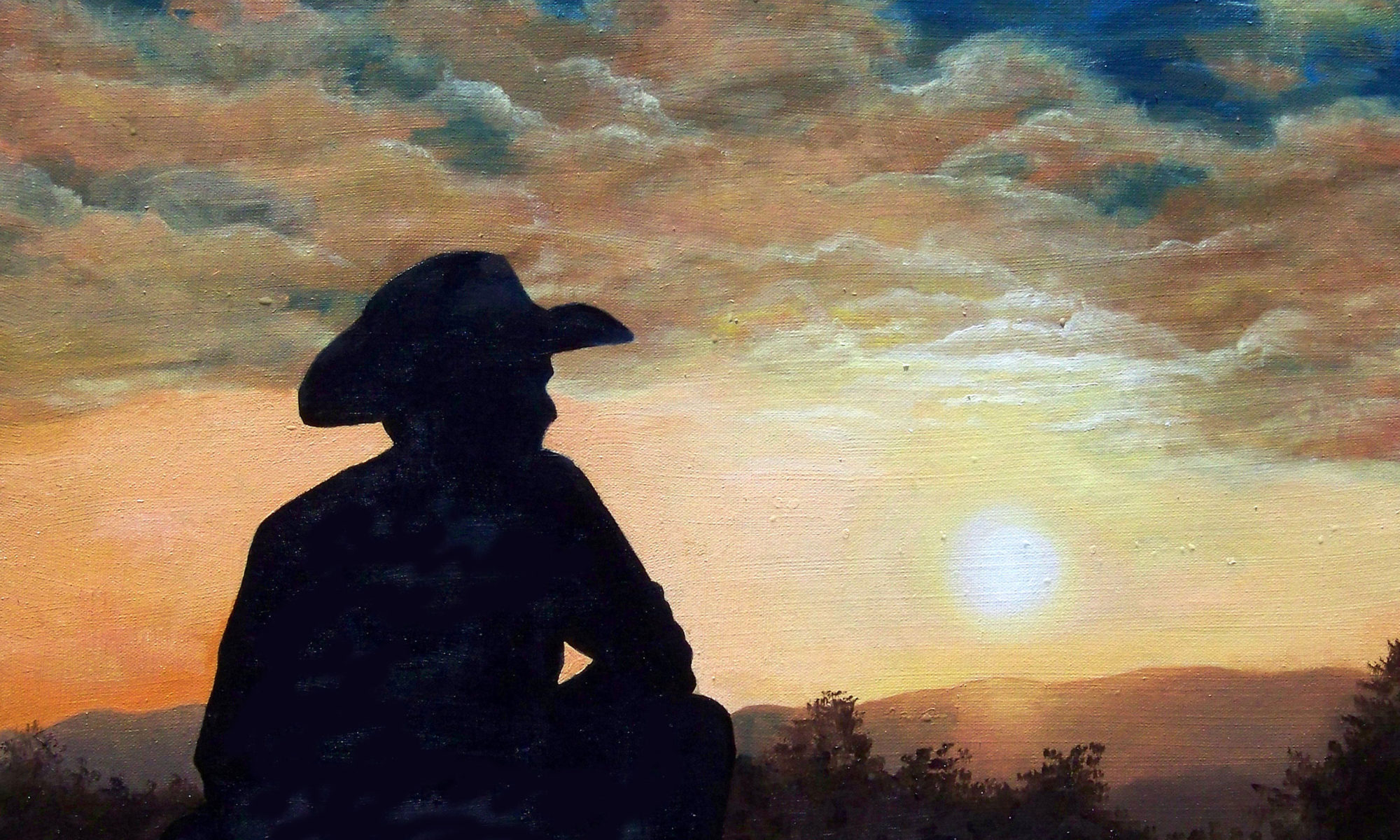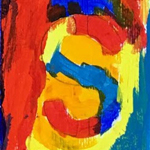
SABLE BRUSH | SYNTHETIC BRUSH
Quick links to more art terms and definitions are located at the end of the list.
Sable Brush
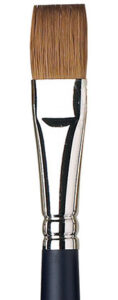
An artist’s brush made from the fur of any member of the weasel family with “red” hair. Despite what their name implies, sable brushes do not come from sables. Some less common natural hairs used for sable brushes are badger, camel, goat, mongoose, ox, pony, and squirrel. Sable brushes are softer and more delicate than bristle or synthetic brushes; however, they are more expensive and require more care. They are great for blending, glazing, and making soft, less-defined marks. The best sizes for this type of brush are one-half inches in width or smaller.
Sacred Art
See “Religious Art.”
Sand Art
The art of pouring different colored sand into a plastic or glass bottle to create a scene or image.
Sandpainting
The art of pouring colored sands and pigments onto a surface to make a temporary or permanent picture.
Sand Sculpture
The art of modeling sand into an artistic form. Sandcastles are a common form of this type of art form; however, sand sculpting has progressed into more elaborate sculptures that you would expect to see in stone, bronze, or wood.
Sans Serif

In typography, a typeface, such as Arial or Helvetica, does not have a serif (crossline) decorating the main strokes of the characters. Sans is French for “without.”
Screen Art
Refers to artwork that has been prepared for the screen-printing process. Proper setup of the artwork is crucial to achieve high-quality results in screen printing.
Screen Printing
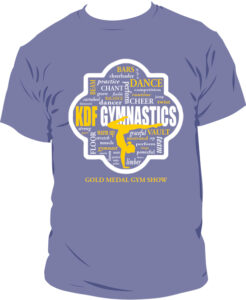
A printmaking technique used to apply inked images to an underlying layer using a mesh stencil or a series of stencils. The ink is distributed to the desired area(s) by being pressed through a porous screen made from fabric (silk or synthetic) stretched tightly over a frame, hence the name screen printing. Also referred to as silk screening or silkscreen printing because silk was once used in the process. The most popular screen in general use is made of polyester. This process is used in printing screen art onto garments, such as T-shirts and sweatshirts, and such items as tote bags, towels, umbrellas, etc.
Sculptor
An artist who creates sculptures.
Sculpture
Any three-dimensional form created as an artistic expression. Sculpture is primarily concerned with space: occupying it, relating to it, and influencing the perception of it.
Seascape
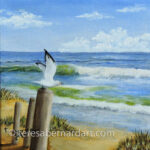
A painting that depicts the sea or a scene offering an expansive view of the ocean or sea. Seascapes include marine landscapes showing life around the sea with lighthouses, and beach scenes, as well as views of the ocean itself. Seascapes, which capture the beauty of the ocean from the shore, should not be mistaken for Maritime Art that portrays life on the open sea. For more on seascape art, click here.
Secondary Colors
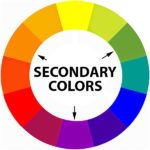
Orange, green, and violet (purple). Secondary colors are created by mixing equal parts of any two primary colors (red, yellow, and blue).
-
- Red + yellow = orange
- Yellow + blue = green
- Blue + red = violet (purple)
Self-Portrait
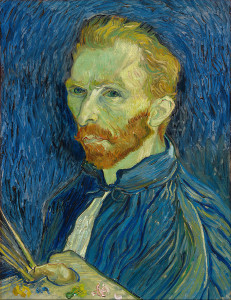
A portrait an artist makes using himself or herself as the subject. It is typically drawn or painted from a reflection in a mirror. A self-portrait may be of the artist only or one that is part of a larger work, including a group portrait. Vincent van Gogh was one of the most well-known and prolific self-portrait artists; between 1886 and 1889, he painted himself more than 43 times.
Also, refers to a portrait taken by the photographer of him/herself, either in a mirror, using a remote release, or with a self-timer.
Sepia
A reddish-brown hue sometimes applied to black-and-white pictures, which gives the finished print an antique appearance often associated with monochrome photographs of the 19th and early 20th centuries.
Septych
Refers to an altarpiece composed of seven panels, intended to be viewed as a whole. While the term is not widely used, it finds its place within the visual arts community. The word derives from “septem,” meaning “seven” in Latin, and “ptychē,” which is Greek for “fold.” Also called, “Heptaptych“. Also see “polyptych.”
Serif
In typography, serifs are the small features at the end of strokes within letters (see San Serif illustration above).
Serigraph
See “screen printing.”
Sfumato
(Pronounced sfoo·mah·toe.)
A Renaissance Italian painting technique that involves gradually blending colors and tones to create a subtle transition between different areas of a painting. This is achieved by applying multiple layers of transparent paint and softening the edges with a brush. The visual result is soft, imperceptible transitions between colors and tones, giving a sense of blurriness or smokiness. Sfumato mimics the effect of human vision or the out-of-focus plane, creating a realistic and atmospheric rendering of facial features and other forms. Leonardo da Vinci, a Renaissance polymath, was a master of the sfumato technique, known for its fine shading and soft transitions between colors and tones. His most famous work, the Mona Lisa, is renowned for its use of this technique without lines or borders.
Shade
A color produced by adding black to a pigment.
Shading
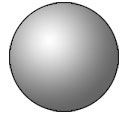
The technique of displaying transitions from light to dark or dark to light in an image. It involves darkening areas that would be in shadow and keeping others light to create illusions of dimension and depth.
Shape
An area that stands out from the space next to it or around it because of a defined boundary or a difference in value, color, or texture. It can be geometric (square, circle, hexagon, etc.) or organic (puddle, blob, splatter, etc.).
Sienna
An opaque pigment often used in oil or acrylic painting. It possesses excellent lightfastness and blends well with other colors to produce various shades and tones. Sienna adds depth and warmth to landscapes, still life, and portraits. It ranks among the earliest pigments used by humans, including ochre and umber, as demonstrated in prehistoric cave paintings, and remains favored by artists even now.
Silhouette
A dark image outlined against a lighter background.
Silkscreen
See “screen printing.”
Simplicity
See “Visual Economy.”
Simultaneous Contrast
A term used in art to describe how two distinct colors or values interact when positioned next to one another. According to the hypothesis, one color can cause the tone and hue of another to look brighter and more vivid. This idea is based on the complimentary color theory, which holds that although colors are the same in nature, their proximity to one another changes how we see them. Simultaneous contrast is essentially an intriguing way that two colors interact, changing our impression of the hue and tone of a surrounding color.
Site-specific Art
A unique form of artwork created to exist in a specific location, often interacting with the environment or architecture of that space. Site-specific art is intentionally created to exist in a specific location, and its unique characteristics are meticulously considered during the planning and creation process. It can be found both indoors and outdoors, engaging with the surroundings in innovative ways.
Sketch
A rapidly executed freehand drawing that is not usually intended as a finished work. It can serve various purposes: capturing what the artist sees, developing ideas, or quickly demonstrating an image or principle. Sketches can be made using various mediums, including silverpoint, graphite, pencil, charcoal, pastel, pen and ink, watercolor, and oil paint. They provide a cost-effective way for artists to explore and record their creative thoughts.
Social Realism
(Art history. Art movement: United States, 1920-1930s. Also known as: urban realism.)
An art movement that arose between WWI and WWII to address social and political concerns. Artists used realism to make their art more accessible and legible to the public, often portraying their subjects as heroic symbols of persistence and strength. This movement aimed to expose and criticize social and political problems like poverty, oppression, injustice, and corruption.
Solvent-free Oils
See “Water-soluble Oil Paint.”
Space (in art)
A design principle that refers to the interval or measurable distance between, around, above, below, or within shapes and forms in an art piece. It can be either negative space (empty) or positive space (occupied). In art, it can also be represented as two-dimensional or three-dimensional space.
Space Art
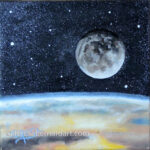
A modern-day art movement still in its infancy, space art attempts to communicate ideas and appreciation for the infinite variety and vastness of outer space. Its subjects are frequently interstellar and interplanetary elements. Thanks to the invention of telescopes, artists can now depict the grandeur of our universe by rendering what they see out there. Space art often features a variety of celestial bodies, including planets, stars, nebulas, galaxies, as well as spacecraft, astronauts, black holes, moons, comets, and asteroids. Sometimes referred to as astronomical art. For more on space art, click here.
Space Artist
An artist who has an interest in the universe and draws inspiration from space and space exploration. A space artist creates space art (also called astronomical art) in various forms such as paintings, sculptures, and abstract imagery.
Split-Complementary
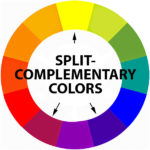
A variation on the complementary color scheme. Split-complementary is a color scheme that takes two colors on either side of the complementary color, rather than the color opposite the key color. This scheme allows for a wider range of colors while maintaining the basic harmony between the key and complementary colors. It has the same visual appeal as the complementary color scheme but with less contrast and tension. Split-complementary color schemes are a safe choice for almost any design due to their ease of manipulation and always look good.
Spot Color
A solid color created using a premixed ink, typically based on Pantone Matching System (PMS) colors. Spot colors are used when an exact color match is required, such as in a company’s logo.
Stained Glass
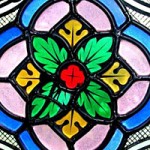
Glass that has been colored or stained by various methods. The term also describes the craft of cutting colored glass into different shapes and assembling them with lead strips to form a decorative window design.
Statue
A free-standing sculpture that realistically depicts full-length figures of people or animals, carved or cast in durable materials like wood, metal, or stone.
Stencil
A piece of stiff paper or another suitable material with a design cut out of it, serving as a template for reproducing the shape. It is also a technique for transferring a design by brushing ink or paint over the cut-out areas onto a surface.
Stenciling
A decorative technique in the visual arts used to replicate designs by applying ink or paint through cut-out holes in cardboard or metal onto a surface. This technique employs stencils, which are templates with pre-designed openings, to produce patterns or pictures on different surfaces.
Still Life
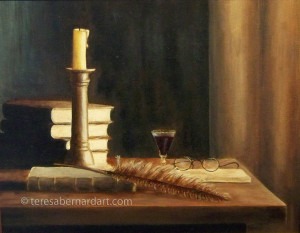
An art form that involves arranging inanimate everyday objects on a table or surface, either natural or man-made. Items like flowers, food, wine, rocks, seashells, or man-made objects like drinking glasses, books, bottles, pottery, dishes, etc. The term still life comes from the French word “nature morte,” meaning “nature dead.” For more on still life art, click here.
Still Life Artist
An artist who creates paintings or drawings of inanimate objects that are either natural or manufactured. The term “still life” comes from the Dutch word “stilleven,” meaning “dead nature” or “motionless life.”
Stippling
A drawing technique consisting of many small dots or specks to construct the image; a method of using small dots to simulate varying degrees of solidity or shading; to paint, engrave, or draw using dots or small touches of the brush, pen, or other tools.
Stomp
A kind of pencil consisting of a tight roll of paper or soft leather, or a cylindrical piece of rubber or other soft material used to rub down hard lines in pencil or crayon drawings to blend the lines of shading to produce a uniform tint.
Street Art
A form of artwork displayed in public spaces, including surrounding buildings, streets, trains, and other publicly viewed surfaces. It encompasses a wide range of visual expressions, from simple graffiti tags to elaborate murals that cover entire buildings. Street art often emerges without formal permission and thrives on accessibility, community engagement, and a rebellious spirit.
Stretcher Bars
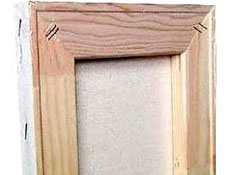
Essential support structures used for stretching canvas or fabric in art. They form the frame for finished canvases by allowing the canvas or fabric to be stretched taut over them. Typically made from wood, metal, or a combination of both, stretcher bars help maintain the flatness and stability of the artwork. They are typically rectangular in shape; however, many artists enjoy painting on square, oval, and even round stretched canvases. Stretcher bars come in various weights and sizes to accommodate the requirements of different types of canvases.
Stretched Canvas
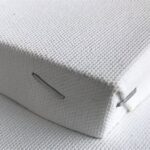
A classic (traditional) type of canvas used by artists to create paintings on top of the canvas surface. Canvas fabric is stretched and stapled to the sides of stretcher bars, typically leaving the edges raw or unpainted. Paintings composed on this type stretched canvas will require a frame before display. For more information see blog article “Three Types of Oil Painting Canvas.”
Stylized Art
A style of art that deviates from realistic representations of subjects to express a specific aesthetic. It can involve simplifying shapes, exaggerating features, or using non-naturalistic colors to create a specific mood or atmosphere. Stylized art is not completely abstract, but rather modifies the natural appearance of the subject. It can be found in various forms, including drawings, paintings, and digital art. Stylized art allows creators to break free from strict realism and infuse their work with a unique visual language that resonates with viewers.
Subject Matter
The topic dealt with, or the subject represented in a work of art. The subject matter is what the artist has chosen to paint, draw, or sculpt.
Support
The material providing a surface upon which an artist applies color, collage, etc.
Surrealism
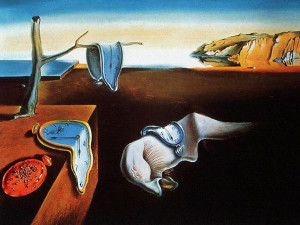
An art and cultural movement that emerged in Europe after World War I. Artists associated with Surrealism aimed to allow the unconscious mind to express itself, resulting in the depiction of illogical or dreamlike scenes and ideas. The movement emphasized positive expression and sought to reunite conscious and unconscious realms of experience, creating a fusion of everyday reality and the fantastical. Key figures include Salvador Dalí, André Breton, and René Magritte.
Symbolism (art)
A late 19th-century French and Belgian movement, aimed to express emotions and ideas through rich, evocative imagery and symbolic representations. Symbolist artists reacted against Western European culture’s rationalism and materialism by using color and line to create scenes with figures from biblical, mythological, or fantastical sources. They moved away from the representational tradition of Classical art, exploring new ways to express psychological truths and spiritual realities. The purpose of paintings in the symbolism art movement was to focus on what each element or the whole symbolizes rather than what the elements literally are.
Symmetrical
A design or composition that uses identical or nearly identical shapes on opposing sides of a dividing line or central axis to demonstrate formal balance. It consists of equivalent components that face each other or rotate around a central axis to promote harmony and balance. The opposite of “asymmetrical.”
Symmetrical Balance
(Also called formal balance.)
A type of visual balance in a composition achieved through the equal distribution of identical forms and weight on both sides of the central axis. Symmetry is the simplest and most prominent type of balance. It creates a secure, safe feeling and a sense of solidity.
Synthetic Brush
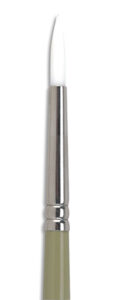
A paintbrush manufactured from either nylon or “Taklon,” a polyester filament. Synthetic brushes offer greater versatility than natural ones because they work well with both acrylic and oil paints. They serve as an economical alternative to natural bristle brushes, but it’s crucial to check that they are specifically designed for use with oil paints.
Some advantages of synthetic brushes are:
-
- They are more resistant to damage from turpentine, insects, or paints.
- Cleanup is easier since they don’t tend to trap paint in the individual hairs.
- The hairs last longer because they are less prone to breaking and are more durable on many different canvas surfaces.
One disadvantage is that less expensive synthetic brushes tend to lose their shape more quickly than natural brushes.
You May Also Like
This art definitions wordfinder is provided as a valuable resource for art enthusiasts. If you like the information here and find it helpful, please consider purchasing a painting. Your support helps to cover the cost of keeping this art sourcebook online. Simply click or tap the thumbnail link of any Teresa Bernard oil painting to view additional details.
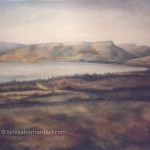
20″ w x 16″ h
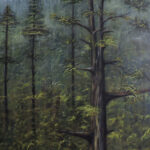
(2023)
24″ w x 36″ h
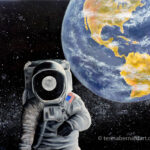
(2022)
30″ w x 24″ h
Art Glossary Quick Links
Contributing to The Art Dictionary
The art definitions wordfinder is a work in progress. New terms and definitions are added on a regular basis. If you know of an art term and definition that isn’t already listed in it but you believe it should be, send it to us and we’ll consider adding it. We’ll let you know if we do. Thanks!
Thanks for reading this!
